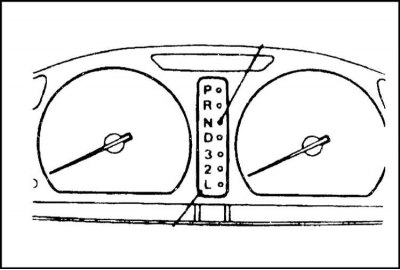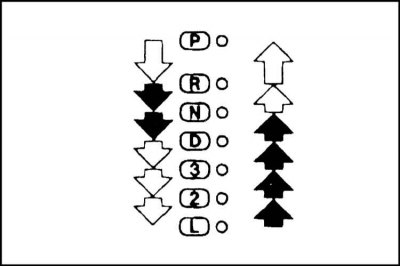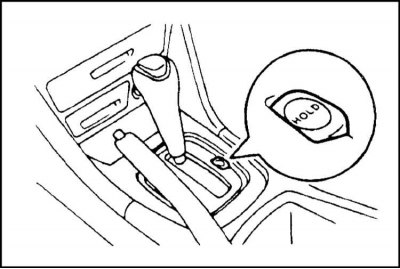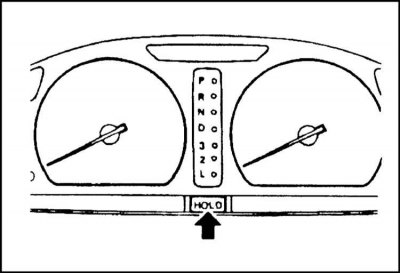The transmission is equipped with an electronic control system that provides optimal gear shifting to suit any driving conditions and road surface conditions.
When the vehicle is moving uphill, the ability to shift the transmission to a higher gear is automatically blocked if the control unit determines that the power unit will not ensure further advance of the vehicle at the same speed.
On steep descents, the control unit can automatically shift the transmission to a lower gear, which improves the engine braking efficiency of the vehicle and reduces brake wear.
Attention! If the transmission does not automatically downshift when driving downhill, the driver must ensure this downshift himself!
Gear selector position indicators

Additional indicator lamps are mounted in the instrument cluster of models equipped with automatic transmission, allowing the driver to easily control the position of the AT range selector.
Flashing of a control lamp of a neutral position of transmission (N) indicates a malfunction of the AT.
Flashing of the control lamp N with a high frequency when set to position "D", "3", "2" or "L" selector lever indicates ATF overheating. The car should be parked in a safe place, with the engine running, shift the transmission to the position "R", then open the hood and let the engine idle for a while. If, after performing this procedure, the transfer of the lever to any of the stipulated positions is not accompanied by the operation of the warning lamp N, you can continue driving, otherwise the car should be driven to the nearest Mitsubishi service station in order to check the condition of the vehicle.
Rules for Using the Range Selector Lever
The transmission range selector lever can be in one of seven detent positions. When starting the engine, the lever should only be in position "P" or "N". If the vehicle is stopped while one of the driving ranges is engaged in the automatic transmission "D", "3", "2", "L", "R", or "N", it is necessary to fully release the gas pedal and depress the brake pedal for reliable braking of the car.
On top of the handle there is a lock button, which allows you to avoid accidentally moving the lever to an unacceptable position. The rules for using the blocking button are shown in the illustration. When moving the selector lever from the position "N" in any of the positions of the movement, be sure to depress the foot brake pedal.
White arrows indicate switches that require pressing the blocker button.
Black arrows indicate switching that does not require pressing the blocker button.
 |  |
Lever positions
Position "R". In this position of the range selector lever, the output shaft of the transmission is mechanically blocked. Always move the range selector lever to the "R" when turning off or starting the engine. To move the range selector lever out of position "R", it is necessary to depress the brake pedal, after releasing the gas pedal. Move the range selector lever to the right and move it out of position "R".
If, after performing all the above steps, you still cannot move the lever from the position "R", you need to unlock it (see below).
To avoid damage to the AT, move the lever to the position "R" only after the vehicle has come to a complete stop.
Note. Removing the key from the ignition lock becomes possible only after moving the selector lever to the position "R".
Position "R". Techniques for controlling the range selector lever when moving it to the position "R" (Reverse) out of position "R" described above. Switching the lever to position "R" out of position "N" (neutral) do it only after the vehicle has come to a complete stop.
The automatic transmission is equipped with a special safety device that prevents the lever from being accidentally moved to the "R", if the vehicle speed exceeds 10÷12 km/h.
If reverse does not engage after the vehicle has come to a complete stop, depress the brake pedal and slowly move the range selector lever first to "N", then to position "R".
If the safety device malfunctions, or if the battery is disconnected from the on-board network or the battery is discharged, it is impossible to engage the reverse range. In this case, it is necessary to remove the reverse range lock (see below).
Position "N". use position "N" (neutral) when starting a stalled engine while the vehicle is moving and during short stops of the vehicle with the engine running. If for any reason you need to move away from the vehicle, first move the range selector lever to the position "R" (Parking). When pulling the lever out of position "N" depress the foot brake pedal.
Position "D". This position is used in most cases when driving in an unloaded urban cycle and when driving on highways. In this position, the transmission uses the full range of forward gears, in appropriate situations, the engine braking mode is automatically activated.
Position "3". When the range selector lever is moved to the position "3", the automatic transmission functions in the same way as the case of switching the range "D". The difference is that the transition to fourth gear is excluded. Range "D3" recommended for towing a trailer in hilly terrain or for engine braking on steep downhill grades. Turning on the range "3" also useful for eliminating unnecessary automatic transmission cycling between third and fourth gears. Such cyclic shifting of the gearbox can be observed, for example, when driving in heavy traffic with frequent decelerations and stops of the car.
For a sharp acceleration of the car when the gearbox is operating in the range "D" or "3" squeeze the gas pedal to the stop. In this case, the gearbox will automatically shift to an adjacent lower gear. If the vehicle speed is low, then the gearbox can immediately switch down two steps.
Position "2". When the range is turned on "2" the automatic transmission will always operate in second gear. When the vehicle is stopped, the transmission does not shift into first gear. The constant engagement of the second gear provides good traction dynamics of the car on the slopes and the possibility of intensive engine braking on steep descents. Range "2" it is recommended to turn it on when driving on a slippery road surface, as well as when driving in deep snow. This helps to prevent severe slippage of the driving wheels of the car.
When the range is turned on "2" while the vehicle is moving, the second gear in the transmission is automatically delayed and occurs only after the vehicle speed drops to a safe level at which the engine speed does not exceed the maximum allowable value.
Position "1". When the range is turned on "1" the automatic transmission will always operate in first gear. If the inclusion of the range "1" produced at speeds over 50 km/h, the transmission will first shift to second gear. The inclusion of an intermediate stage allows you to eliminate sharp and unexpected engine braking.
Switch of operating modes AT
 |  |
The automatic transmissions used on the considered models of Mitsubishi cars have two modes of operation: "AUTO" And "HOLD". The first of which is the main one and is enabled by default. To enable the mode "HOLD" press the special button located to the right of the selector lever. Return to position "AUTO" performed by pressing the same button again.
Mode "AUTO" Designed for normal vehicle use. In this mode, the vehicle moves in economy mode with moderate depressing of the gas pedal and is transferred to the power mode with full depressing of the pedal.
Mode "HOLD" should be selected to ensure smooth starting of the vehicle when starting to move on slippery road surfaces. At the same time, if you start moving by moving the lever to a position other than the position "L", immediately engages second gear. Upon reaching a speed of 30÷60 km/h (19÷37 mph), the transmission will switch to the maximum gear for the selected range, which allows you to use the selector lever in manual transmission simulation mode, with the only difference being that when you fully depress the gas pedal, the transmission will automatically switch to a lower gear (kickdown).
Maximum allowable vehicle speeds in various gear ranges
The Specifications show the maximum allowable vehicle speeds when engaging various ranges of the automatic transmission. If the values specified in the Specifications are exceeded, the tachometer needle enters the red zone of the scale, indicating that the permissible engine speed is exceeded. At the same time, the electronic unit of the engine control system begins to limit the speed of the crankshaft, reducing the fuel supply, which can be felt by changing the engine operating mode. The operation of the engine returns to normal as soon as the tachometer needle leaves the red zone of the scale.
To avoid engine damage, before changing gear, make sure that the tachometer needle does not go beyond the maximum allowable speed in this gear and is not in the red zone of the scale.
Overtaking
While overtaking, depressing the gas pedal to the floor automatically shifts the transmission to the nearest gear to the currently selected downshift (4th to 3rd, 3rd to 2nd, 2nd to 1st), - there is no need for any switching of the selector lever.
Brief stop
During short stops, for example at a traffic light, you can leave the transmission in gear while holding the car with the brakes.
For longer stops with the engine running, move the selector lever to the "N", - before starting to move, do not forget to move the lever to the position "D".
When stopping for a short time on an uphill slope, do not hold the car motionless with the accelerator - use the foot or parking brake.
During braking, avoid depressing the gas pedal - if the selector lever is not in the position "N" or "R", this can lead to unexpected acceleration.
